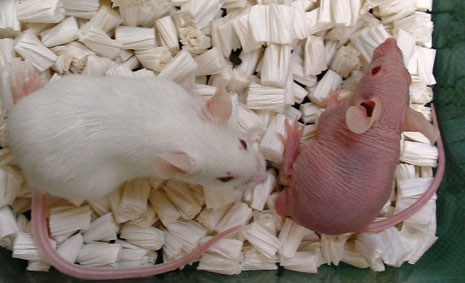HOME > mice > HR mice
Strain Detail: HR mice
| Strain information | |
|---|---|
| Resource No. | nbio003 |
| Strain name | HR |
| Strain Nomenclature | |
| Common name/Synonyms | hairless mice, Alopecia model mice |
| Strain types | inbred |
| Background strain | |
| Institution | The Institute of Medical Science, the university of Tokyo (IMSUT) |
| Developer | unknown |
| Depositor | |
| Conditions of distribution | In publishing the research results obtained by use of the mice, mention in the article that the mice are derived from IMSUT. :contact us |
| Animal Health Report | |
| Strain description |  This HR strain was established by the introduction of hairless allele (hr) to BALB/c from hairless mice derived from USA at IMSUT. Then the mice were introduced into National Institute of Health/National Institute of Infectious Diseases in 1981. HR mice are normal until the first hair cycle started in the embryonic stage, but they don't have the second hair cycle normally started in 2-3 weeks old. Therefore, it's characteristic that they have their hairs until 2-3 weeks, but later they will lose their hairs from the back of their heads to tails. Genetic analysis in our bank revealed that the HR mice share the same hairless mutation as HRS/J, Skh:HR-1 and Hos:HR-1. Based on the analysis, we estalisheda genotyping PCR for hairless alleles(Ref. 4). Generally, the homozygous females can't take care of her pups because of mammary gland anomaly. Therefore, this strain should be maintained by mating between homozygous (hairless) males and heterozygous (normal hair) females. These mice are useful for studies related skins because skin tumors are induced easily by chemical mutagens. About hair cycleThe hair cycle goes through three stages called anagen, catagen and telogen (1). Hair matrix cells divide and make hairs in the stage of anagen. In the catagen stage, hair matrix cells disappear by apoptosis. This apoptosis event is related with TGF-β1 (2). Through the process of telogen after a period of fixed time, hair matrix cells divide again and make new hairs in the next stage of anagen after old hairs fall out. |
| Reference(s) |
|
| Resource information | |||
|---|---|---|---|
| Cryopreserved sperm | In-house | Genotype | hr/hr |
| Medium | FERTIUP | ||
| From other institutions | Genotype | ||
| Medium | |||
| Cryopreserved embryo | In-house | Mating System | IVF : (hr/+) female x (hr/hr) male |
| Genotype | hr/hr, hr/+ | ||
| Medium | EFS40 | ||
| From other institutions | Mating System | ||
| Genotype | |||
| Method | |||
| Strain status / Availability | Cryopreserved sperm | Within 1 month | |
| Cryopreserved embryo | Within 1 month | ||
| Live animals | Approx. 2 months | ||
| Gene information | |
|---|---|
| Mutation types | spontaneous mutation |
| Gene symbol | Hr |
| Gene name | hairless |
| Genotyping information | Genotyping PCR for Hr alleles in PDF format. |
